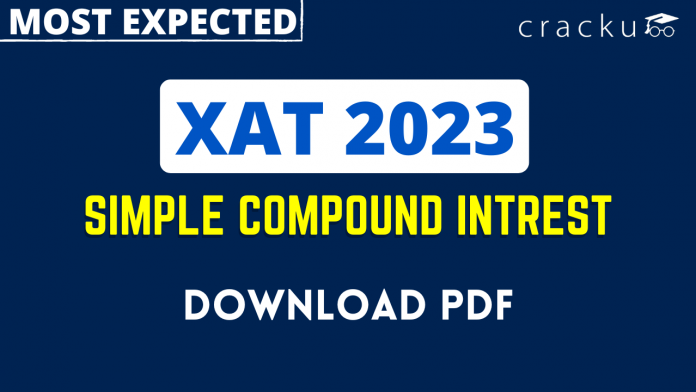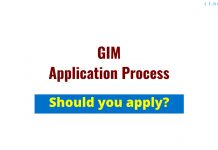Simple Compound Intrest Questions for XAT
Download Simple Compound Intrest Questions for XAT PDF – XAT Simple and Compound Intrest questions pdf by Cracku. Practice XAT solved Simple Compound Intrest Questions paper tests, and these are the practice question to have a firm grasp on the Simple Compound Intrest topic in the XAT exam. Top 20 very Important Simple Compound Intrest Questions for XAT based on asked questions in previous exam papers. The XAT question papers contain actual questions asked with answers and solutions.
Download Simple Compound Intrest Questions for XAT
Enroll to XAT 2023 Crash Course
Question 1: Ms suchi deposits an amount of 24000 to obtain in a simple interest at the rate of S.I 14 p.c.p.a for 8 years .what total amont will ms suchi gets at the end of 8 years
a) 52080
b) 28000
c) 50880
d) 26880
e) none of these
1) Answer (C)
Solution:
Amount deposited = Rs. 24,000
Rate = 14 % and time = 8 years under simple interest
=> $S.I. = \frac{P \times R \times T}{100}$
= $\frac{24000 \times 14 \times 8}{100}$
= $240 \times 112 = Rs. 26,880$
$\therefore$Total amount will ms Suchi gets at the end of 8 years
= $24000 + 26880 = Rs. 50,880$
Question 2: What would be the compound interest obtained on a amount 3000 at the rate of 8% per annum after 2 years?
a) 501.50
b) 499.20
c) 495
d) 510
e) None of these
2) Answer (B)
Solution:
Amount = Rs. 3000
Time = 2 years and rate = 8% under compound interest
=> $C.I. = P [(1 + \frac{R}{100})^T – 1]$
= $3000 [(1 + \frac{8}{100})^2 – 1]$
= $3000 [(\frac{27}{25})^2 – 1] = 3000 (\frac{729}{625} – 1)$
= $3000 \times \frac{104}{625} = 104 \times 4.8$
= $Rs. 499.20$
Question 3: What would be the simple interest obtained on a amount 5670 at the rate of 6 pcpa after 3 years?
a) 1020.60
b) 1666.80
c) 1336 .80
d) 1063.80
e) none of these
3) Answer (A)
Solution:
Principal amount = Rs. 5,670
Time period = 3 years and rate = 6% under simple interest.
=> $S.I. = \frac{P \times R \times T}{100}$
= $\frac{5670 \times 6 \times 3}{100}$
= $56.7 \times 18 = Rs. 1,020.6$
Question 4: A sum of money was invested for 14 years was in Scheme A which offers simple interest at a rate of 8% p.a. The amount received from Scheme A after 14 years was then invested for two years in Scheme B which offers compound interest (compounded annually) at a rate of 10% p.a. If the interest received from Scheme B was Rs. 6,678, what was the sum invested in Scheme A?
a) Rs. 15,500
b) Rs. 14,500
c) Rs. 16,500
d) Rs. 12,500
e) Rs. 15,000
4) Answer (E)
Solution:
Let the sum invested in scheme A = $Rs. 100x$
Time = 14 years and rate = 8% under simple interest
=> $S.I. = \frac{P \times R \times T}{100}$
= $\frac{100x \times 8 \times 14}{100} = 112x$
=> Amount invested in Scheme B = $100x + 112x = Rs. 212x$
Time = 2 years and rate = 10% under compound interest.
$C.I. = P [(1 + \frac{R}{100})^T – 1]$
=> $6678 = 212x [(1 + \frac{10}{100})^2 – 1]$
=> $6678 = 212x [(\frac{11}{10})^2 – 1] = 212x (\frac{21}{100})$
=> $0.21x = \frac{6678}{212} = 31.5$
=> $x = \frac{31.5}{0.21} = 150$
$\therefore$ Sum invested in scheme A = $100 \times 150 = Rs. 15,000$
Question 5: The difference between the compound interest and the simple interest for a period of 2 years at the rate of 10% per annum is Rs. 50. Find the principal.
a) Rs. 4000
b) Rs. 5000
c) Rs. 5500
d) Rs. 4500
e) None of these
5) Answer (B)
Solution:
Let the principal amount = $Rs. 100x$
Time = 2 years and rate = 10%
=> $C.I. = P [(1 + \frac{R}{100})^T – 1]$
= $100x [(1 + \frac{10}{100})^2 – 1]$
= $100x [(\frac{11}{10})^2 – 1] = 100x (\frac{121 – 100}{100})$
= $100x \times \frac{21}{100} = 21x$
=> $S.I. = \frac{P \times R \times T}{100}$
= $\frac{100x \times 10 \times 2}{100} = 20x$
It is given that difference between compound and simple interest = $21x – 20x = 50$
=> $x = 50$
$\therefore$ Principal = $100 \times 50 = Rs. 5,000$
Question 6: The simple interest accrued on an amount of Rs. 16,500 at the end of three years is Rs. 5,940. What would be the compound interest accrued on the same amount at the same rate in the same period? (rounded off to two digits after decimal)
a) Rs. 6681.31
b) Rs. 6218.27
c) Rs. 6754.82
d) Rs. 6537.47
e) None of these
6) Answer (A)
Solution:
Principal amount = Rs. 16,500
Simple interest earned = Rs. 5,940 and time = 3 years
Let rate of interest = $R \%$
=> $S.I. = \frac{P \times R \times T}{100}$
=> $5940 = \frac{16500 \times R \times 3}{100}$
=> $R = \frac{5940}{165 \times 3}$
=> $R = 12 \%$
Now, compound interest accrued on the same amount at the same rate in the same period = $P [(1 + \frac{R}{100})^T – 1]$
= $16,500 [(1 + \frac{12}{100})^3 – 1]$
= $16,500 [(\frac{28}{25})^3 – 1] = 16,500 (\frac{21952 – 15625}{15625})$
= $16,500 \times \frac{6327}{15625} = Rs. 6681.31$
Question 7: What would be the compound interest accrued on an amount of Rs. 8000 at the rate of 15 p.c.p.a. in three years ?
a) Rs. 4283
b) Rs. 4051
c) Rs. 4167
d) Rs. 4325
e) None of these
7) Answer (C)
Solution:
Principal amount = Rs. 8,000
Time period = 3 years and rate of interest = 15% under compound interest.
=> $C.I. = P [(1 + \frac{R}{100})^T – 1]$
= $8,000 [(1 + \frac{15}{100})^3 – 1]$
= $8,000 [(\frac{23}{20})^3 – 1] = 8,000 (\frac{12167 – 8000}{8000})$
= $12167 – 8000 = Rs. 4,167$
Question 8: The interest received on a sum of money when invested in scheme A is equal to the interest received on the same sum of money when invested for 2 years in scheme B. Scheme A offers simple interest (p.c.p.a.) and scheme B offers compound interest (compounded annually). Both the schemes offer the same rate of interest. If the numerical value of the number of years for which the sum is invested in scheme A is same as the numerical value of the rate of interest offered by the same scheme, what is the rate of interest (p.c.p.a) offered by scheme A?
a) 3
b) $2{1 \over {77}}$
c) $3{4 \over {99}}$
d) $2{2 \over {99}}$
e) 2
8) Answer (D)
Solution:
Let sum invested in both schemes = $Rs. P$
Let rate of interest in both schemes = $R \%$
Time period in scheme A = $R$ years
=> Simple interest under Scheme A = $\frac{P \times R \times R}{100}$
= $Rs. \frac{P R^2}{100}$
Also, interest received from both schemes is also same, and time period under scheme B = 2 years
=> Compound interest under scheme B = $P [(1 + \frac{R}{100})^T – 1]$
=> $\frac{P R^2}{100} = P [(1 + \frac{R}{100})^2 – 1]$
=> $\frac{R^2}{100} = [1 + (\frac{R}{100})^2 + \frac{2 R}{100}] – 1$
=> $\frac{R}{100} = \frac{R}{10000} + \frac{1}{50}$
=> $\frac{R}{100} (1 – \frac{1}{100}) = \frac{1}{50}$
=> $\frac{R}{100} \times \frac{99}{100} = \frac{1}{50}$
=> $R = \frac{100 \times 100}{99 \times 50}$
=> $R = \frac{200}{99} = 2 \frac{2}{99} \%$
Question 9: What is the compound interest accrued on an amount of Rs. 12000 at the rate of 9 p.c.p.a. at the end of 2 years.
a) Rs. 2545
b) Rs. 2257.2
c) Rs. 2986
d) Rs. 2775.4
e) None of these
9) Answer (B)
Solution:
Total amount under compound interest
= $12000 (1 + \frac{9}{100})^2$
= $12000 \times 1.09 \times 1.09$
= $14257.2$
$\therefore$ Compound Interest = 14257.2 – 12000
= Rs. 2,257.2
Question 10: Ms. Anisha deposits an amount of Rs. 35000 to obtain a simple interest at the rateof 15 p.c.p.a. for 4 years. What total amount will Ms. Anisha get at the end of 4 years ?
a) Rs. 56000
b) Rs. 60500
c) Rs. 52000
d) Rs. 48500
e) None of these
10) Answer (A)
Solution:
Principal amount = Rs. 35,000
Rate of interest = 15% and time period = 4 years
Simple interest = $\frac{35000 \times 15 \times 4}{100}$
= Rs. $21,000$
Total amount Ms. Anisha will get = 35000 + 21000
= Rs. 56,000
Question 11: The simple interest accrued on a amount of Rs. 12,450 at the end of 6 years is Rs. 8,964. What is the rate of interest p.c.p.a. ?
a) 8
b) 14
c) 10
d) 12
e) None of these
11) Answer (D)
Solution:
Principal amount = Rs. 12,450
Let rate of interest = $r$ %
=> Simple interest = $\frac{12450 \times r \times 6}{100} = 8964$
=> $r = \frac{8964 \times 100}{12450 \times 6}$
=> $r = 12$%
Question 12: The simple interest accrued on an amount of Rs. 19,800 at the end of three years is Rs. 7,128. What would be the compound interest accrued on the same amount at the same rate in the same period ?
a) Rs. 8934.6784
b) Rs. 8017.5744
c) Rs. 7861.8754
d) Cannot be determined
e) None of these
12) Answer (B)
Solution:
Let rate of interest be $r$ %
=> Simple interest = $\frac{19800 \times r \times 3}{100} = 7128$
=> $r = 12$%
Now, C.I. = $19800 [(1 + \frac{12}{100})^3 – 1]$
= $19800 (1.12^3 – 1)$
= $19800 * 0.405 = 8019$
= Rs. 8017.5744
Question 13: What will be the the compound interest acquired on sum of Rs 12,000/- for 3 years at the rate of 10 % per annum ?
a) 2,652
b) 3,972
c) 3,960
d) 3852
e) None of these
13) Answer (B)
Solution:
Principal amount = Rs. 12,000
Time period = 3 years and rate of interest = 10% under compound interest.
=> $C.I. = P [(1 + \frac{R}{100})^T – 1]$
= $12,000 [(1 + \frac{10}{100})^3 – 1]$
= $12,000 [(\frac{11}{10})^3 – 1] = 12,000 (\frac{1331 – 1000}{1000})$
= $12 \times 331 = Rs. 3,972$
Question 14: The simple interest accrued on an amount of Rs. 10,530 at the end of 5 years is Rs. 6,318. What is the rate of interest p.c.p.a. ?
a) 8
b) 14
c) 10
d) 12
e) None of these
14) Answer (D)
Solution:
Principal amount = Rs. 10,530
Let rate of interest = $r$ %
=> Simple interest = $\frac{10530 \times r \times 5}{100} = 6318$
=> $r = \frac{6318 \times 100}{10530 \times 5}$
=> $r = 12$ %
Question 15: Mr. Madhur deposits an amount of Rs. 58,750/- to obtain a simple interest at the rate of 12 p.c:p.a:for years. What total amount will Mr. Madhur get at the end of 4 years?
a) Rs. 91,230/-
b) Rs. 86,950/-
c) Rs. 74,760/-
d) Rs. 69,540/-
e) None of These
15) Answer (B)
Solution:
Principal amount = Rs. 58,750
Rate of interest = 12% and time period = 4 years
Simple interest = $\frac{58750 \times 12 \times 4}{100}$
= Rs. $28,200$
Total amount Mr. Madhur will get = 58750 + 28200
= Rs. 86,950
Question 16: The simple interest accrued on an amount of Rs. 9,530/- at the end of 6 years is Rs. 2,859/-. What is the rate of interest p.c:p.a:?
a) 5
b) 7
c) 9
d) 11
e) None of these
16) Answer (A)
Solution:
Principal amount = Rs. 9,530
Let rate of interest = $r$ %
=> Simple interest = $\frac{9530 \times r \times 6}{100} = 2859$
=> $r = \frac{2859 \times 100}{9530 \times 6}$
=> $r = 5$ %
Question 17: What is the compound interest accrued on an amount of Rs. 12,000/- at the rate of 10 p.c.p.a. at the end of 3 Years?
a) Rs. 3,972/-
b) Rs. 2,567/-
c) Rs. 4,780/-
d) Rs. 5,609/-
e) None of these
17) Answer (A)
Solution:
Total amount under compound interest
= $12000 (1 + \frac{10}{100})^3$
= $12000 \times 1.1 \times 1.1 \times 1.1$
= $15972$
$\therefore$ Compound Interest = 15972 – 12000
= Rs. 3,972
Question 18: Ms. Suchi deposits an amount of Rs. 24,000 to obtain a simple interest at the rate of 14 p.c.p.a. for 8 years. What total amount will Ms. Suchi get at the end of 8 years?
a) Rs. 62080
b) Rs. 28,000
c) Rs. 50,880
d) Rs. 26,880
e) None of these
18) Answer (C)
Solution:
Principal = Rs. 24,000
S.I. = $\frac{24000 \times 14 \times 8}{100}$
= Rs. 26,880
$\therefore$ Total amount = 24000 + 26880
= Rs. 50,880
Question 19: What would be the compound interest obtained on an amount of Rs. 3,000 at the rate of 8 p.c.p.a. after 2 years?
a) Rs. 501.50
b) Rs. 499.20
c) Rs. 495
d) Rs. 510
e) None of these
19) Answer (B)
Solution:
Amount = $P (1 + \frac{R}{100})^T$
= $3000 (1 + \frac{8}{100})^2$
= $3000 (1 + \frac{2}{25})^2$
= $3000 \times \frac{27}{25} \times \frac{27}{25}$ = Rs. 3499.20
$\therefore$ C.I. = 3499.20 – 3000
= Rs. 499.20





